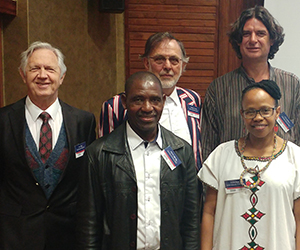
From the left, front: Prof Nhlanhla Mathonsi,
President of the NSSA, and Prof Thenjiwe Meyiwa,
Registrar at DUT.
Left, back (from the UFS): Prof Peter Raper,
Research Fellow at the ULFE and executive
member of the scientific council and paper
selection committee, Prof Theodorus du Plessis,
Director of the Unit for Language Facilitation
and Empowerment, and JC van der Merwe,
acting Director of the Institute for
Reconciliation and Social Justice.
Photo: Supplied
The 19th Names Society of Southern Africa (NSSA) International Conference saw delegates from around the world make their way to the University of the Free State (UFS) Bloemfontein Campus to study names as well as naming systems.
The conference took place from 20 to 22 September and was organised by the Unit for Language Facilitation and Empowerment (ULFE) at the UFS, alongside the NSSA. Delegates from South Africa, Lesotho, Zimbabwe, Zambia, Germany, and Taiwan attended.
The NSSA is a society dedicated to the study of names, naming, and naming systems. Members of the society come from a variety of disciplines, but all share an interest in names and their meaning.
Symbolism and naming in public sphere
The topic of this year’s conference was Symbolism and Instrumentality in Naming with categories of research which included anthroponyms, geographical names, names in history, literary onomastics, brand names, and politics of naming in a public sphere.
Issue of gender in naming systems
Keynote speakers included Prof Thenjiwe Meyiwa, Registrar at the Durban University of Technology (DUT), and Prof Peter Raper, Professor Extraordinaire at the UFS, Research Fellow at the ULFE, and executive member of the scientific council and paper selection committee.
In her address entitled, Naming is to gender as gender is to naming: Emerging Onomastics Scholarship, Prof Meyiwa noted that analysing names using gender enquiry is a potentially useful tool for identifying various communities’ values, belief systems, and perceptions as it relates to sexes.
“The talk called for the development of what I refer to as ‘feminist onomastics theory and research practice,’ which should primarily seek to bring about change and/or reimagine onomastics research."